The Dawn of the Tetraquark
May 22, 2014
On April 9, 2014, scientists at the Large Hadron Collider "unambiguously" observed a new particle dubbed Z(4430)−. This negatively charged particle is about 4.7 times more massive than a proton and deviates from the traditional quark model.1 But what is the traditional quark model, what does “unambiguously” mean, and what implications might this new particle have?
Particle Physics Timeline
Particle physics has a rich history tracing back to ancient Greek philosophers but has expanded greatly in the 20th and 21st centuries. The field describes the mechanisms of all the fundamental forces of nature as particles that transfer energy and momentum from one particle to another. These particles that mediate the forces on an atomic and subatomic level have become intertwined with the theories of the origin of our universe.
Before tackling the new “tetraquark,” we’ll begin with a timeline of particle physics and the fundamental physics behind the field as it stands today. The appendix to this article has a review of the history of particle physics.
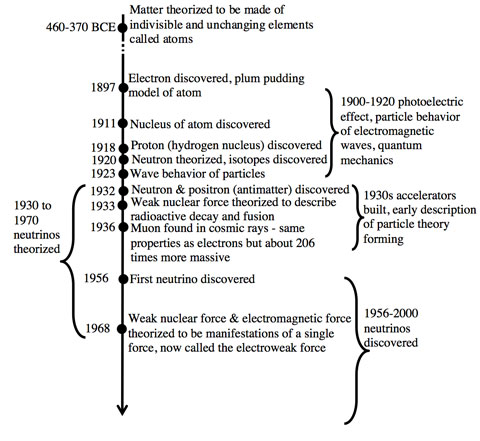
Image Credit: Heide Doss/Physics Central
Forces of Nature
By the 1930s it was clear to scientists that there were four fundamental forces in nature that could describe all observed interactions.
• The gravitational force in which mass attracts mass. The strength of this force increases as mass increases and decreases as distance between masses increases. This is the weakest of all forces.
• The electromagnetic force in which like charges repel and opposite charges attract, and moving charges create magnetic fields which can interact with moving charged particles and other magnetic fields. This force increases as charge increases and decreases as the distance between charges increases.
• The weak nuclear force or weak force responsible for radioactive decay and involved in fusion processes. This was later found to be connected to the electromagnetic force and are thought to be two different manifestations of the same force called the electroweak force.
• The strong nuclear force or strong force, which holds together the nucleus of atoms. This force is much stronger than the other forces and its strength is felt only over distances on the order of a quadrillionth of a meter, or less.
Fields vs. Particles
Now that we have some history under our belt, let’s focus on the physics behind particles and fields. For example, electric charges exert forces on each other proportional to the size of the charges and inversely proportional to the distance between them squared. This helped inspire Faraday to think about this force in a new way:
Rather than describing the force between two charged particles one could describe a force field that any given charged particle could create. The force field created by a charged particle is called the electric field. It describes the force per charge that the charged particle creating the field would exert on another charge if it were there.
Place the actual charge within the field, and it feels a force equal to its charge multiplied by the electric field. The field can be thought of as the mechanism that allows two distant objects to interact. One often thinks of these force fields that permeate space as affecting the space. This is field theory.
The interaction between charged particles can also be described as the absorption or emission of particles (packets of electromagnetic energy) called photons. Energy and momentum are transferred between charged particles by the absorption or emission of a photon. In this case, the photon is the carrier of the electromagnetic force and energy. This is particle theory.
Richard Feynman described this exchange with what is known as Feynman diagrams (shown below).
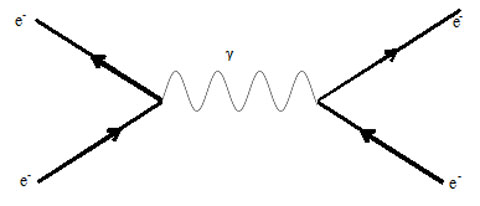
The force between two electrons (e−) can be viewed as the passing of a photon (y) between them.
These particles can be virtual, meaning they pop into and out of existence from the vacuum field (which permeates all space).
Einstein showed that mass is a form of energy, and that mass can be turned into pure energy and energy into mass. As an example, an electron and a positron can annihilate and create two photons.
Similarly photons can interact and become an electron-positron pair, as shown below. Note that in Feynman diagrams antiparticles are represented as going backwards in time.
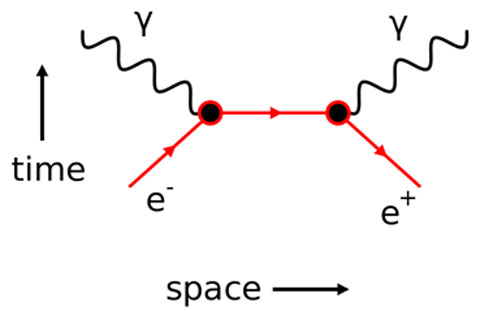
Feynman diagram of electron (e-) positron (e+) annihilation, producing two photons (y).
Image Credit: bitwise via Wikimedia Commons.
The Vacuum
With all of this talk of particles abounding in the universe, you’d think they’d fill up a lot of space, but most of space is empty.
Our everyday experiences are filled with what appears to be solid material to us, but atoms have 99.99% of all their matter in a sphere with a diameter on the order of 10-15 m (a quadrillionth of a meter), yet, with all their electrons, an average atom extends over a size of about 10-10 m (ten billionth of a meter).
This means that the mass of an atom only takes up about a thousandths quadrillionth of its entire spatial extent, most of it being empty. And beyond our world is a lot of empty space interspersed with planets, stars, and other extraterrestrial objects.
When you think of a vacuum you probably think of a volume of space that contains absolutely nothing. But quantum field theory posits that a vacuum field exists throughout all of space and it consists of constantly fluctuating fields that are zero on the average, but have a non-zero probability to become large.
As a side note, the Higgs field is part of the vacuum field. Particles with mass do so because of their interaction with the Higgs field, which permeates all space.
If a field becomes large at an instant then a pair of particles might pop into existence, which would soon annihilate. The vacuum can also be thought of as particles constantly being created and destroyed. This fits with Heisenberg’s Uncertainty Principle as well. If the lifetime of a particle is short, then its energy (and hence its mass) can be large.
Particle Types
In the 1950’s, scientists observed that there are particles that seem to be fundamental, meaning they are not made of anything else. An example of this is the electron, the muon, and neutrinos. These are called leptons, meaning light particles.
There were other particles found that had properties between those of leptons and protons, neutrons and other more massive particles. These are called mesons meaning middle particles. Examples of mesons are the pion and the rho meson. Mesons are important because they are involved in strong interactions (the type of interaction that holds the nucleus together).
In 1934 Hideki Yukawa theorized that the exchange of mesons was responsible for the strong nuclear force between nucleons, much like atoms absorb and emit electromagnetic energy, nucleons were believed to absorb and emit mesons. This is not true, however the idea that particles are exchanged during an interaction is the basis of quantum electrodynamics (QED) and quantum chromodynamics (QCD). QCD is quark theory.
Particles such as protons and neutrons are called baryons, or heavy particles. It was observed that there is a strong force, a manifestation of the strong interaction that holds the nucleus together.
Hadrons (strong particles) are particles that are involved in strong interactions and consist of mesons and baryons, but it was not understood why these particles were involved in strong interactions. Furthermore, there were some problems with symmetry and conservation rules that were not fitting with what scientists believed should happen. This is where the theory of quarks helped.
Flavorful Quarks
Because of issues of symmetry, it was thought that perhaps mesons and baryons were made up of smaller particles. In 1956 Murray Gell-Mann and George Zweig independently came up with a theory of these smaller particles. Gell-Mann named his particle the quark.
The quark was thought to make up mesons and baryons, and if it did exist, it would explain the observations made of baryons and mesons that seemed otherwise to contradict parts of their underlying theories.
It was also believed that gluons would be exchanged during strong force interactions in much the same way that photons are exchanged during electromagnetic interactions.
Assuming symmetrical relationships, gluons would be massless particles traveling at the speed of light that would be absorbed or emitted by quarks. These gluons would also (like photons) be involved in the creation of quarks and the annihilation of quarks.
With the introduction of quarks came a new set of fundamental particles that make up all that we know exists in matter. The table below lists all known elementary particles we know of.
The gauge bosons are the carries of the four fundamental forces of nature. The Z and W particles are exchanged in the electroweak interactions (they act like photons in electromagnetic interactions, however these have mass unlike all the other particles that at as carriers for the fundamental forces of nature).
The Higgs boson is still under scrutiny in the scientific community. The Higgs boson observed in 2013 has not yet been accepted as the one predicted by theory, but it has been accepted as a Higgs boson. Current theories suggest that the Higgs field and its corresponding particle (the Higgs boson) interact with W and Z particles, slowing them down and hence causing them to have mass.
The graviton (a massless particle theorized to be absorbed and emitted during gravitational interactions) has not yet been observed and is not listed below.
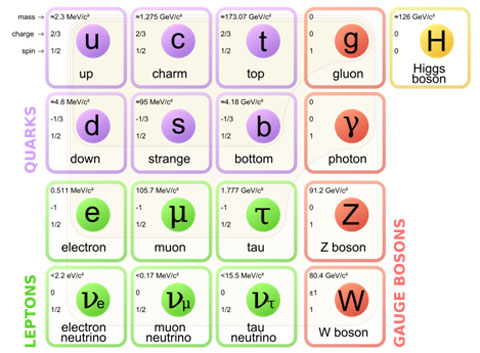
Table of quarks, leptons, and bosons.
Image Credit: Fermilab/DOE Office of Science Particle Data Group/PBS NOVA
Our everyday matter can now be described as:
Leptons (light particles) are fundamental particles that cannot be broken down further and do not contain quarks.
Mesons (middle particles) that consist of a quark and an antiquark. All particles have a “twin” particle or anti-particle. These are almost the same. The charge is always opposite in sign and some other characteristics are opposite.
Baryons (heavy particles) that are particles consisting of three quarks. For example the proton is made of two up quarks and a down quark and the neutron is made of an up quark and two down quarks. All baryons are made of three particles. The up and down quarks are the most stable and long-lived quarks found in nature.
Baryons and mesons make up a category of particles called hadrons. Hadrons (strong particles) are involved in strong interactions, which manifests the strong force. The strong force arises from the exchange of gluons.
Quarks have never been found isolated, i.e., just one quark on its own. If one were to try to get one quark on its own by having a high-energy collision, the energy involved to break apart a baryon or meson would be enough to also create sets of quark pairs, so one could not isolate a quark this way.
However, scattering experiments have provided enough evidence of all six types, or flavors, of quarks: up, down, charm, strange, top, and bottom. In the past, top and bottom were called truth and beauty and hence many particle physics groups have the word beauty associated with them.
Quarks also have a special type of charge besides electric charge. This new charge is called color charge, and not because it is associated with a color, but because there are three different types of this new charge and three types for the anti-charge, which lends itself well to the colors of light.
The primary charges are colored red, blue, and green (like the primary colors of light). The anti-colors, carried by anti-quarks, are: anti-blue which is yellow, because yellow light is made of red and green lights only; anti-red which is cyan, because blue and green lights make cyan; and anti-green which is magenta because blue and red lights make magenta.
Again, it is important here to stress that this color charge has nothing to do with light or color. It is some charge characteristic that quarks have that is not the electric charge, and it follows conservation rules like other charged particles.
Gluons also have color charge, and the strong force between quarks is called the color force. Quarks bound in groups always must be colorless, that is, their color charge must add up to make white, meaning there must be a red, green, and blue mixed together. The proton and neutron have this.
Mesons, which are only made of two quarks, then must be made of a quark and an anti-quark which carries an anti-color charge.
Below is a representation of the quarks, and their color charge, of a proton, neutron, and mesons.

From left to right: proton, neutron, pion+ (pi+ meson), with the quark color charge shown. A line above the quark symbol indicates an anti-quark. The squiggly line represents the interchange of gluons.
Image credit: Arpad Horvath via Wikimedia Commons.
In Feynman diagrams we can show how a neutron may undergo beta decay and turn into a proton, emitting an electron and neutrino. In the decay process, a down quark decays into an up quark emitting a W− particle. The W− particle then decays into an electron and a neutrino.
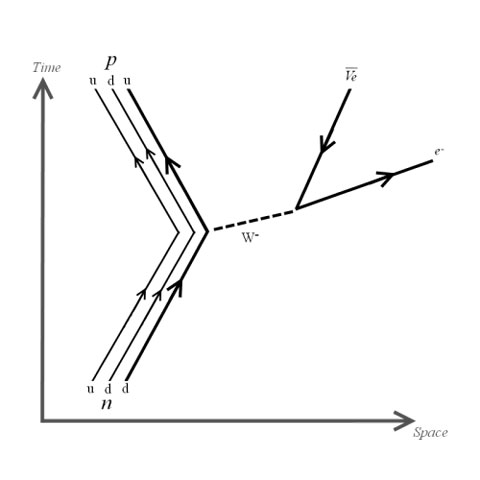
Feynmann diagram of beta decay.
Image credit: Joel Holdsworth via Wikimedia Commons.
This is the traditional quark model, and what is now called the standard model. It has had plenty of evidence to back it up, although there are a few things that have suggested that perhaps particle physicists don’t have it all figured out yet.
For example, the current standard model works great for hadrons made of two and three quarks. More quarks in one particle was not believed to occur, and was never observed — that is until recently.
The Tetraquark Emerges
Particles that seemed to deviate from the traditional quark model, in that they contained four quarks, were first observed in 2003. But there’s been insufficient evidence to claim a tetraquark exists — at least until now.
There were other claims in 2008 from CERN’s Large Hadron Collidor (LHC) and Japan’s Belle that pointed toward a tetraquark, and even a possible pentaquark observation, but none was sufficient enough to pass the required scientific criteria. That is until work published in April 2014 by the Large Hadron Collider Beauty experiment (LHCb) collaboration.1,2
The LHCb colloboration reported “unambiguously” finding the Z(4430)−, a particle of mass 4430 MeV or 4.756 u = 7.897 * 10-27 kg, and a negative electric charge equal to that of an electron. But what does “unambiguously” mean? It means that they put an extremely high criteria on finding it, and that it was observed in many more instances than the criteria they placed.
Particle physicists often describe the statistical significance of their measurements in terms of the standard deviation. The standard deviation is a measure of the variation in the data. When scientists use standard deviations to describe the significance of their results it means they are describing the probability of their measurements versus seeing such measurements by chance or by some other anomaly.
In every day terms, 2 sigma (2σ) means, ± 2 standard deviations of a normal curve, which encompasses 95.4% of the data, as shown below, with 4.6% on the sides. In most instances if you have found something to within 5% it means you are 95% sure that your measurements are valid and true, and 5% might be a fluke. Overall you have pretty good statistics backing you up.
If you have 3σ (3 on each side of the center as shown below) then you are up to 99.6% certain of your measurements. Note also that this is a two sided curve, meaning that one considers the standard deviations symmetrically.
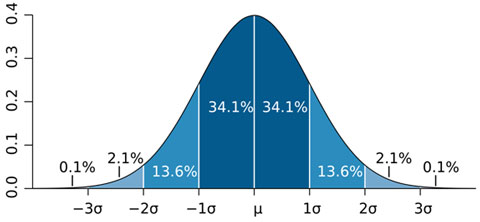
Image of the normal distribution showing 3 standard deviations on each side of the mean value.
Image credit: Mwtoews vs Wikimedia Commons
Particle physicists tend to put a lower limit of 5σ on their findings, and often they are one sided curves, meaning they just consider the probability of chance at one end of the curve because the other side can be ruled out.
For the Higgs Boson that was recently found, it was 5σ above the mean, which means they only need to look at the little amount on the right side of the curve as the chance part. The probability of the observation occurring by chance or some fluke is then 1 in 3.5 million, and the scientists are 99.99997% sure they have found a valid measurement of a particle.
If it were a two-sided normal curve, and they could not rule out one side of the curve, then it would have been a 1 in 1.75 million chance. If they can do better than 5σ, then it is even more likely that they have found what they say they have found.
This tetraquark was found to be within 13.9σ. Consequently, the scientists are all but certain that their measurements are real and not a fluke.
They were able to obtain such high levels of certainty because they were able to produce more than 180 million collisions, which resulted in 25,200 observable decays to analyze. With so much data, they were able to determine a lot about this particle.
This particle’s measured mass is about 4.72 times more massive than the proton. From observations of the decay chain the researchers could rule out certain quantum numbers describing the particle by conservation laws. From their measurements they determined this particle to have a spin-parity of 1+, meaning if it is made up of quarks it must be made up of an even number since quarks have spin ½.
They also determined that the smallest number of quarks, and type of quarks that can make this particle are four quarks: charm, anti-charm, down, and anti-up, or:

Moving Forward
This discovery has upended the traditional view that particles can’t be made of more than three quarks. Even though this particle was short-lived, it was clearly measured and clearly existed for some time. More than three quarks can combine to form a particle, and particle physicists will continue to try to understand the building blocks of all we know.
To see images of the data, click the link to the LHCb paper, or go to their website and review their 9 April 2014 post.
References and Resources
1. Large Hadron Collider Beauty Experiment webpage, April 9, 2014 postinghttp://lhcb-public.web.cern.ch/lhcb-public/
2. LHCb collaboraion: Aaij, R. et al. Observation of the resonant character of the Z(4430)− state, Submitted to Physical Review Letters April 2014
http://arxiv.org/abs/1404.1903
3. Nambu, Y. Quarks, Frontiers in Elementary Particle Physics, World Scientific, Philadelphia (1985)
4. Giancoli, Physics, Sixth Ed., Ch 32, Pearson (2005)
5. Lamb, E., 5 Sigma – What’s That?, Scientific American, Observations Blog, 17 July 2012
http://blogs.scientificamerican.com/observations/2012/07/17/five-sigmawhats-that/
6. David, Higgs: Is it one-sided or two-sided, Understanding Uncertainty, 7 March 2012.
http://understandinguncertainty.org/higgs-it-one-sided-or-two-sided
“Produced by the Winton programme for the public understanding of risk based in the Statistical Laboratory in the University of Cambridge.”
—H.M. Doss
Appendix: Particle Physics Background History
Although the ancient Greeks didn’t have access to vast particle colliders, they were still very interested in the smallest building blocks of the material world. The Greek Philosopher Democritus (460-370 BCE) and his mentor Leucippus, theorized that all matter was made up indivisible and unchanging elements they called atoms. Before 1900, however, not much was known about the parts of the atom as we know it today.
The electron was discovered in 1897, and scientists believed that electrons and positively charged objects mixed together like plum pudding to form an atom. This “plum pudding” model, took precedence until around 1911 when evidence pointed to a centralized, dense, and positively charged part of the atom.
Evidence suggested that positively charged particles incident on a thin sheet of metal foil usually went through the foil, but sometimes they bounced back at large angles. The conservation of momentum requires that the sum of the momenta in each direction of all the particles involved in a collision must be the same before and after the collision.
The momentum of a particle is simply its mass multiplied by its velocity. Using the conservation of momentum, physicists found that the incoming charged particles must have collided or interacted with something massive, positively charged, and concentrated in a tiny space.
Ernest Rutherford believed this to be where all the protons in an atom were located, with the electrons orbiting this massive center, much like planets orbit the Sun. The nucleus of an atom was discovered around 1911, and the proton (a hydrogen nucleus) was discovered in 1918. The neutron wasn’t even theorized until 1920, when studies found that the same atomic element sometimes had a different mass.
With the photoelectric effect and early quantum theorems between 1900-1920 came the idea that light, and all electromagnetic waves, could act as a particle called a photon. A photon is a discrete packet of energy. One of the patterns we find in nature is that nature is symmetric.
Based on this, Louis de Broglie in 1923 theorized that if electromagnetic waves could act like particles, then particles could act like waves. This provided an explanation for some concerns at the time for the orbital model of the atom. It is also a key part of quantum mechanics. Because of this inherent wave nature of matter, there is a limit on how well we can simultaneously know certain quantities that describe a particle.
This limit is called Heisenberg’s Uncertainty Principle, which puts a lower limit on how well we can simultaneously know a particle’s location and momentum, and also its energy at a given time.
In 1932, the neutron was discovered in experiments. Neutrons act as a buffer between protons. At this point, the core parts of the modern atom were finally known while elements, and their isotopes, were being discovered.
The nucleus does not fly apart, even though there are plenty of positively charged protons in it, and scientists had long-known that like charges repel (electromagnetic force). The neutrons in the nucleus were thought to be helpful in buffering the situation, but a new force was needed, and one that was significantly stronger than the electromagnetic force.
This new force was called the strong nuclear force. From observations, scientists determined that this force is extremely strong at distances on the order of 10-15 m (a femtometer) or a quadrillionth of a meter — roughly the size of the nucleus. At larger distances, the force is negligible.
Still more particles were being observed. In 1932, scientists also discovered the positron: a positively charged particle otherwise identical to the electron and the first “anti-matter” particle to be observed.
By 1933, much had been learned about radioactive decay, and Enrico Fermi introduced the idea that another force must be responsible for these decay processes and fusion processes. He called it the weak nuclear force. In 1968, it was theorized that the weak nuclear force and the electromagnetic force were both manifestations of a single force now called the electro-weak force.
In 1936 scientists discovered the muon, found in cosmic rays. Muons have all the same properties as electrons except their mass is about 206 times that of an electron. Next came neutrinos, theorized between 1930 and 1970, and discovered between 1956 and 2000. In 1950 the lambda baryon was discovered, and the sigma baryon was discovered. Particle accelerators were being built in the 1930s and the early description of particle theory was forming.














